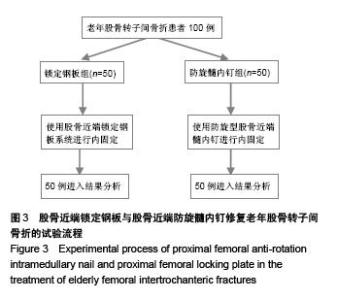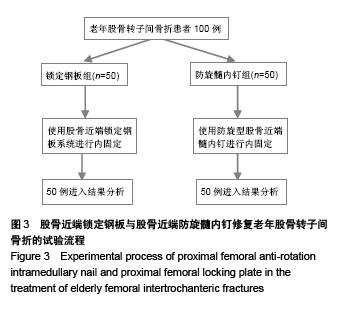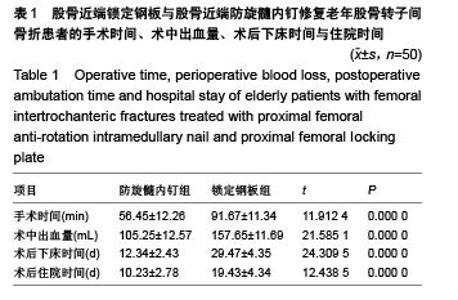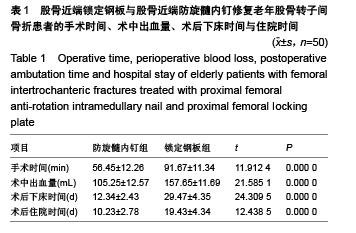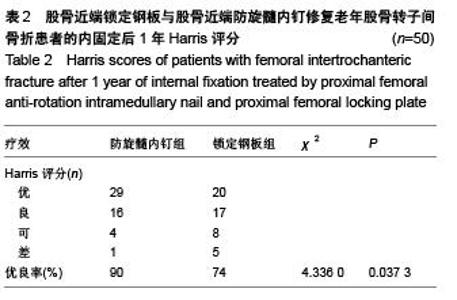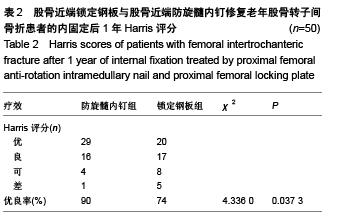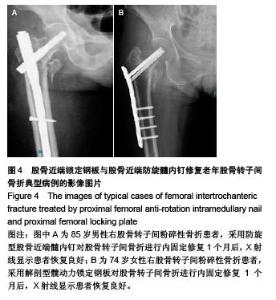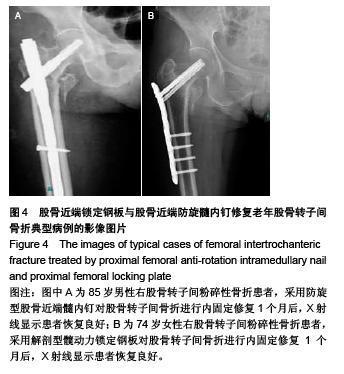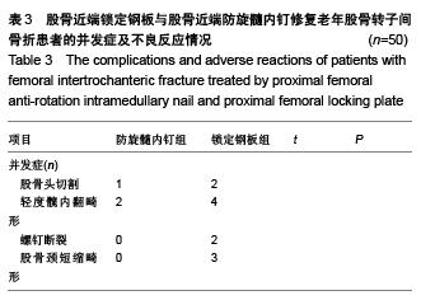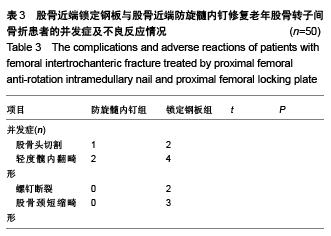Chinese Journal of Tissue Engineering Research ›› 2015, Vol. 19 ›› Issue (53): 8579-8584.doi: 10.3969/j.issn.2095-4344.2015.53.009
Previous Articles Next Articles
Proximal femoral locking plate and anti-rotation intramedullary nail in repair of intertrochanteric fracture in the elderly: 1-year follow-up
Tian Geng1, Yang Li-li2, Wu Yong3
- 1Department of Orthopedic Surgery, Qionghai City People’s Hospital, Qionghai 571400, Hainan Province, China; 2the Second Hospital of Jilin University, Changchun 130041, Jilin Province, China; 3Affiliated Haikou Hospital, Xiangya School of Medicine, Central South University, Haikou 570208, Hainan Province, China
-
Received:2015-11-24Online:2015-12-24Published:2015-12-24 -
About author:Tian Geng, Associate chief physician, Department of Orthopedic Surgery, Qionghai City People’s Hospital, Qionghai 571400, Hainan Province, China -
Supported by:a Project funded by Hainan Provincial Health Department, China, No. 2014-43
CLC Number:
Cite this article
Tian Geng, Yang Li-li, Wu Yong . Proximal femoral locking plate and anti-rotation intramedullary nail in repair of intertrochanteric fracture in the elderly: 1-year follow-up[J]. Chinese Journal of Tissue Engineering Research, 2015, 19(53): 8579-8584.
share this article
| [1] 管英.股骨近端锁定钢板术治疗老年股骨转子间骨折52例效果分析[J].中国老年学杂志,2011,31(10):1890-1891.
[2] 张天浩,宋烜,陈羽,等.防旋股骨近端髓内钉与股骨近端锁定钢板治疗股骨转子间骨折疗效比较[J].临床骨科杂志, 2015,18(1): 57-60.
[3] 陈荣涛,寿康全,付纳新,等.动力髋螺钉、股骨近端锁定钢板及股骨近端防旋髓内钉治疗老年转子间骨折临床疗效对比[J].实用医学杂志,2014,10(18):2933-2935.
[4] 张欣,杨朔.髋动力带锁钢板与股骨近端锁定钢板治疗股骨转子间骨折的疗效观察[J].广西医学,2014,2(12):1811-1817.
[5] 丁伟国,顾春江,陶初华,等.股骨近端锁定钢板结合空心拉力螺钉治疗股骨转子间骨折[J].临床骨科杂志,2012,15(6):676-678.
[6] 张先军,陈洋.股骨近端锁定钢板治疗不稳定股骨转子间骨折[J].临床骨科杂志,2014,17(1):73-74.
[7] 花奇凯,熊凯,赵劲民,等.MIPPO技术结合股骨近端锁定钢板治疗股骨转子间骨折26例[J].广西医科大学学报,2012,29(5): 752-754.
[8] 杨灵,江伟,刘跃洪,等.股骨近端锁定钢板治疗股骨转子间骨折的生物力学研究[J].创伤外科杂志,2015,8(2):135-137.
[9] 李健,黄海,杨波,等.股骨近端防旋髓内钉与股骨近端解剖锁定钢板治疗老年股骨转子间骨折的比较研究[J].中国矫形外科杂志, 2011,19(18):1513-1516.
[10] 刘志军,王贤月.股骨转子间骨折手术疗效分析[J].中华实用诊断与治疗杂志,2014,28(1):79-80.
[11] 龙秋平,廖前德,尹科,等.股骨转子间骨折两种置入内固定的隐性失血比较[J].中国组织工程研究,2013,16(30):5460-5465.
[12] 曾超,王一任,魏捷,等.股骨近端防旋髓内钉与动力髋螺钉固定治疗股骨转子间骨折的Meta分析[J].中南大学学报(医学版),2012, 37(6):606-615.
[13] 米宁.高仕长.PFNA与DHS治疗高龄股骨转子间骨折临床疗效对比研究[J].重庆医学,2013,11(28):3353-3354.
[14] 陈振强,刘国英,孙占胜,等.股骨近端防旋髓内钉治疗老年人股骨转子间骨折疗效分析[J].中华老年医学杂志,2014,33(7): 772-774.
[15] 黄文虎,朱法国,任东彪,等.闭合复位股骨近端防旋髓内钉治疗老年股骨转子间骨折[J].中医正骨,2014,10(5):52-54.
[16] 李理,杨渝勇,曹兴,等.应用股骨近端防旋髓内钉治疗老年股骨转子间骨折的回顾性队列研究[J].中国医师进修杂志,2014,37(z1): 127-128.
[17] 夏平光,蔡贤华,王庆,等.股骨近端锁定钢板与股骨近端防旋髓内钉治疗AO A3型老年股骨粗隆间骨折的疗效比较[J].中国老年学杂志,2014,10(8):2276-2277.
[18] 陈栋.股骨近端防旋髓内钉与股骨近端锁定钢板治疗老年股骨转子间骨折的临床比较研究[D].苏州:苏州大学,2014.
[19] 阳春华.股骨近端锁定钢板与PFNA治疗老年股骨粗隆间骨折的疗效分析[J].中外健康文摘,2014,6(23):175-176.
[20] 王瑞良,张媛,李向辉,等.股骨近端防旋髓内钉和锁定钢板治疗股骨粗隆间不稳定骨折的疗效比较[J].实用临床医药杂志,2014, 18(23):92-93.
[21] 符国良,李俊,孟志斌,等.解剖型锁定钢板与股骨近端防旋髓内钉内固定治疗股骨粗隆间骨折的58例临床疗效观察[J].医学研究杂志,2014,43(4):145-147.
[22] 易文辉,张叔云,沈翔,等.股骨近端防旋髓内钉与锁定钢板治疗股骨近端骨折的疗效比较[J].局解手术学杂志,2013,22(4): 423-424.
[23] 秦伟光,李忠华,张秀华,等.股骨近端防旋髓内钉与解剖型锁定钢板治疗老年不稳定型股骨转子间骨折疗效比较[J].临床骨科杂志, 2014,10(3):324-326,329.
[24] 独行业,周正明,殷小军,等.股骨近端防旋髓内钉在股骨转子间骨折内固定失效翻修中的应用[J].中华创伤杂志,2015,31(1): 45-49.
[25] 季烈峰,陈巨坤,徐丁,等.股骨近端防旋髓内钉与解剖锁定钢板治疗老年股骨转子间骨折的疗效比较[J].中华创伤骨科杂志,2014, 16(8):727-730.
[26] 赖金平,冯虹,赵敏,等.股骨近端解剖型锁定钢板治疗老年骨质疏松性EvanⅢ、Ⅳ型股骨粗隆间骨折疗效分析[J].湖南师范大学学报(医学版),2015,25(1):113-115.
[27] 朱永亮.锁定钢板与股骨近端防旋髓内钉治疗股骨近端骨折的疗效比较研究[J].医学信息,2014,8(2):36-37.
[28] 郑常青.股骨近端防旋髓内钉与锁定钢板治疗股骨粗隆间骨折的临床疗效比较[J].江西医药,2014,33(11):1162-1164.
[29] 冯小兵,屈建华,谭捷,等.股骨近端防旋髓内钉与股骨近端解剖型锁定钢板治疗老年人股骨转子间骨折的对比研究[J].中国保健营养(上旬刊),2014,24(7):3728-3729.
[30] 杨周生,陈晓生,赖福生.解剖型锁定钢板与PFNA治疗老年不稳定型粗隆间骨折的临床观察[J].中国实用医药,2015,11(12): 35-36.
[31] 吕俊生,李军,裴介成,等.股骨近端防旋髓内钉和解剖锁定钢板治疗老年股骨转子间骨折的疗效分析[J].泰山医学院学报,2013, 34(11):862-863.
[32] 安维军,郭玮玮,邱少东,等.动力髋螺钉与微创内固定系统钢板倒置治疗老年股骨转子间骨折的疗效比较[J].中华创伤骨科杂志, 2013,15(8):731-733.
[33] 郑琼,勘武生,徐敏超,等.防旋股骨近端髓内钉治疗老年不稳定型股骨转子间骨折[J].中华创伤骨科杂志,2009,11(9):809-812.
[34] 郭小微,李开南.股骨转子间骨折Gamma钉内固定术后髋内翻的发生原因及预防[J].中华创伤骨科杂志,2013,15(8):728-730.
[35] 孙强,许平安,郑加法,等.三种手术方式固定不稳定性股骨转子问骨折的生物力学研究[J].中华创伤杂志,2012,28(12):1078- 1082.
[36] 李健,黄海,杨波,等.股骨近端防旋髓内钉与股骨近端解剖锁定钢板治疗老年股骨转子间骨折的比较研究[J].中国矫形外科杂志, 2011,19(18):1513-1516.
[37] 任国旗,廖宏伟,钱永刚等.解剖型锁定钢板与PFNA治疗老年股骨粗隆间骨折回顾性分析[J].中国实用医刊,2013,40(10):68-70.
[38] 黄永栋,赵辉,张虓.PFNA与解剖型锁定钢板内固定治疗老年股骨粗隆间骨折的疗效比较[J].中国骨与关节损伤杂志,2015, 30(4):402-404.
[39] 樊继华.三种方法治疗高龄股骨粗隆间骨折的前瞻对照研究[J].医药前沿,2014,(20):275-276.
[40] 鞠智.PFNA与股骨近端解剖锁定板、DHS治疗老年股骨粗隆间骨折的临床疗效对比[D].大连:大连医科大学,2013.
[41] 彭继杰.中西医结合治疗老年转子间骨折(Tronzo-EvanⅡ、Ⅲ型)的疗效分析[J].延边医学,2014,(36):206-207.
[42] 邹璇.DHS、LPFP、PFNA在老年股骨粗隆间骨折中的疗效对比分析[J].江西医药,2013,48(9):790-793.
[43] 宋健,程珂珂,喻爱喜,等.PFNA与LCP内固定治疗成年股骨粗隆间骨折疗效的Meta分析[J].中国骨与关节损伤杂志,2015,30(6): 577-581.
[44] 王自鸿,徐伟,彭明学.手术治疗股骨转子间骨折316例的疗效分析[J].中国当代医药,2013,20(20):11-13,16.
[45] 朱彬.股骨转子下SeinsheimerⅡ-ⅢA型骨折两种内固定方式的三维有限元分析[D].衡阳:南华大学,2013.
[46] 周国万,徐国红,蒋剑锋.解剖型锁定钢板与防旋股骨近端髓内钉治疗老年粗隆间骨折的临床疗效比较[J].实用医学杂志,2015, (18): 3030-3033.
[47] 叶书熙.股骨近端新型解剖锁定钢板的应用解剖学及生物力学三维有限元研究[D].广州:南方医科大学,2013.
[48] 李江伟,谢齐林,杨辉,等.86例老年股骨转子间骨折内固定治疗效果分析[J].重庆医学,2014,(29):3962-3964.
[49] 湛梅圣,张彬,王万垠,等.股骨近端防旋髓内钉与股骨近端锁定板治疗股骨转子间骨折的疗效比较[J].骨科,2015,6(2):105-106.
[50] 武军龙.骨质疏松患者转子间骨折锁定钢板内固定和PFNA内固定的比较[J].中国实用医药,2015,(23):76-78.
[51] 黄桃园,刘志英,何向东,等.股骨近端防旋髓内钉(PFNA)治疗老年股骨粗隆骨折46例临床研究[J].浙江创伤外科,2014,(3):374- 375.
[52] 黄桃园,刘志英,何向东,等.股骨近端防旋髓内钉(PFNA)治疗老年股骨粗隆骨折46例临床研究[J].浙江创伤外科,2014,(2): 191-192,193.
[53] 邓红敏,刘志诚.转子间斜行截骨结合股骨近端防旋髓内钉固定治疗股骨近端骨折术后髋内翻畸形[J].中医正骨,2015,(10): 17-19.
|
| [1] | Chen Ziyang, Pu Rui, Deng Shuang, Yuan Lingyan. Regulatory effect of exosomes on exercise-mediated insulin resistance diseases [J]. Chinese Journal of Tissue Engineering Research, 2021, 25(25): 4089-4094. |
| [2] | Chen Yang, Huang Denggao, Gao Yuanhui, Wang Shunlan, Cao Hui, Zheng Linlin, He Haowei, Luo Siqin, Xiao Jingchuan, Zhang Yingai, Zhang Shufang. Low-intensity pulsed ultrasound promotes the proliferation and adhesion of human adipose-derived mesenchymal stem cells [J]. Chinese Journal of Tissue Engineering Research, 2021, 25(25): 3949-3955. |
| [3] | Yang Junhui, Luo Jinli, Yuan Xiaoping. Effects of human growth hormone on proliferation and osteogenic differentiation of human periodontal ligament stem cells [J]. Chinese Journal of Tissue Engineering Research, 2021, 25(25): 3956-3961. |
| [4] | Sun Jianwei, Yang Xinming, Zhang Ying. Effect of montelukast combined with bone marrow mesenchymal stem cell transplantation on spinal cord injury in rat models [J]. Chinese Journal of Tissue Engineering Research, 2021, 25(25): 3962-3969. |
| [5] | Gao Shan, Huang Dongjing, Hong Haiman, Jia Jingqiao, Meng Fei. Comparison on the curative effect of human placenta-derived mesenchymal stem cells and induced islet-like cells in gestational diabetes mellitus rats [J]. Chinese Journal of Tissue Engineering Research, 2021, 25(25): 3981-3987. |
| [6] | Hao Xiaona, Zhang Yingjie, Li Yuyun, Xu Tao. Bone marrow mesenchymal stem cells overexpressing prolyl oligopeptidase on the repair of liver fibrosis in rat models [J]. Chinese Journal of Tissue Engineering Research, 2021, 25(25): 3988-3993. |
| [7] | Liu Jianyou, Jia Zhongwei, Niu Jiawei, Cao Xinjie, Zhang Dong, Wei Jie. A new method for measuring the anteversion angle of the femoral neck by constructing the three-dimensional digital model of the femur [J]. Chinese Journal of Tissue Engineering Research, 2021, 25(24): 3779-3783. |
| [8] | Meng Lingjie, Qian Hui, Sheng Xiaolei, Lu Jianfeng, Huang Jianping, Qi Liangang, Liu Zongbao. Application of three-dimensional printing technology combined with bone cement in minimally invasive treatment of the collapsed Sanders III type of calcaneal fractures [J]. Chinese Journal of Tissue Engineering Research, 2021, 25(24): 3784-3789. |
| [9] | Qian Xuankun, Huang Hefei, Wu Chengcong, Liu Keting, Ou Hua, Zhang Jinpeng, Ren Jing, Wan Jianshan. Computer-assisted navigation combined with minimally invasive transforaminal lumbar interbody fusion for lumbar spondylolisthesis [J]. Chinese Journal of Tissue Engineering Research, 2021, 25(24): 3790-3795. |
| [10] | Hu Jing, Xiang Yang, Ye Chuan, Han Ziji. Three-dimensional printing assisted screw placement and freehand pedicle screw fixation in the treatment of thoracolumbar fractures: 1-year follow-up [J]. Chinese Journal of Tissue Engineering Research, 2021, 25(24): 3804-3809. |
| [11] | Shu Qihang, Liao Yijia, Xue Jingbo, Yan Yiguo, Wang Cheng. Three-dimensional finite element analysis of a new three-dimensional printed porous fusion cage for cervical vertebra [J]. Chinese Journal of Tissue Engineering Research, 2021, 25(24): 3810-3815. |
| [12] | Wang Yihan, Li Yang, Zhang Ling, Zhang Rui, Xu Ruida, Han Xiaofeng, Cheng Guangqi, Wang Weil. Application of three-dimensional visualization technology for digital orthopedics in the reduction and fixation of intertrochanteric fracture [J]. Chinese Journal of Tissue Engineering Research, 2021, 25(24): 3816-3820. |
| [13] | Sun Maji, Wang Qiuan, Zhang Xingchen, Guo Chong, Yuan Feng, Guo Kaijin. Development and biomechanical analysis of a new anterior cervical pedicle screw fixation system [J]. Chinese Journal of Tissue Engineering Research, 2021, 25(24): 3821-3825. |
| [14] | Lin Wang, Wang Yingying, Guo Weizhong, Yuan Cuihua, Xu Shenggui, Zhang Shenshen, Lin Chengshou. Adopting expanded lateral approach to enhance the mechanical stability and knee function for treating posterolateral column fracture of tibial plateau [J]. Chinese Journal of Tissue Engineering Research, 2021, 25(24): 3826-3827. |
| [15] | Zhu Yun, Chen Yu, Qiu Hao, Liu Dun, Jin Guorong, Chen Shimou, Weng Zheng. Finite element analysis for treatment of osteoporotic femoral fracture with far cortical locking screw [J]. Chinese Journal of Tissue Engineering Research, 2021, 25(24): 3832-3837. |
| Viewed | ||||||
|
Full text |
|
|||||
|
Abstract |
|
|||||
